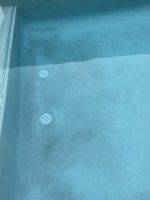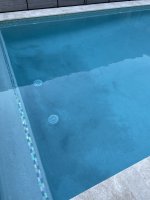


 Hello all decided to finally join after being along time lurker before deciding to build new pool.
Hello all decided to finally join after being along time lurker before deciding to build new pool.My pool was plastered in Sep 2021 with quartz plaster. Everything began as expected and start up was performed by builder via traditional bicarb start up. Everything looked amazing and perfectly even the first 4 weeks of pool. Builder kept tabs of pool the first month. Only small hiccup was hose end touched plaster during initial fill and left small orange stain which easily brushed off. Pool was brushed consistently every day. Good amount of plaster dust was present but disappeared quickly. Pool pump was run continuously. At the 30 day mark salt was added and SWG was turned on. Later that day I noticed two small dark spots form in deep end close to main drain. I brought it up to builder and he said might be from salt and they would treat it. Unfortunately stain has continued to spread across deep end an continues to spread. The builder has attempted various treatments. Jacks magic number 2 and 1 with little effect or change. Then it was decided we should do an acid bath/zero alkalinity treatment. This was performed and it decreased/lightened the stains significantly. Unfortunately the stains have returned. At this point not sure if this is metals, mottling from improper plaster practices, or calcium scale with metals trapped underneath. I have spoken to a few people that insist this is metals/minerals based staining. There is talk of another stain treatment, acid wash, or replaster. Any help is greatly appreciated.
Today’s water parameters
FC 5
TA 80
CYA 40
PH 7.4
CH 450
CH of fill water 150
Last picture is initial stain and others are current condition of stains.
Last edited:

